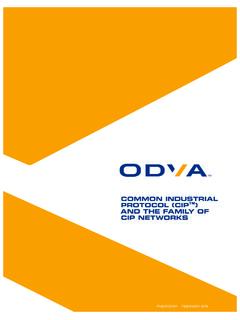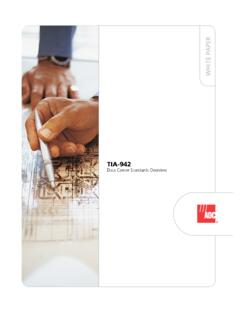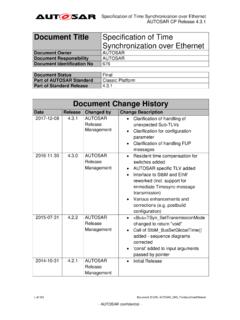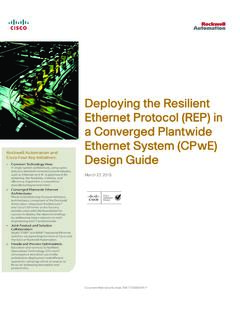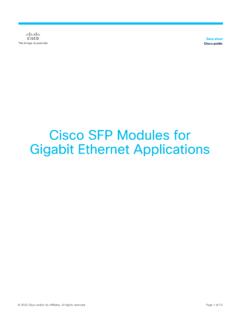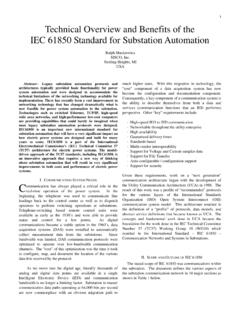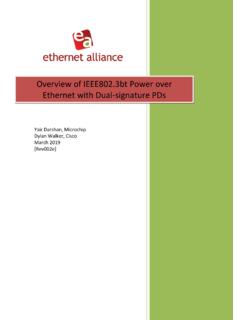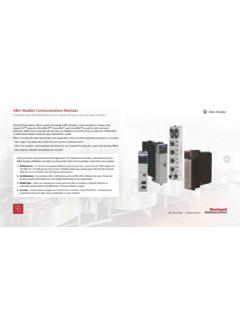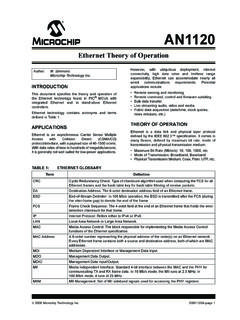Transcription of EtherNet/IP Quick Start for Vendors Handbook
1 Quick Start for VendorsHandbookA Guide for EtherNet/IP NoticeEtherNet/IP Quick Start for Vendors HandbookPublication Number: PUB00213R0 Copyright 2008 Open DeviceNet Vendor Association, Inc. (ODVA).All rights reserved. For permission to reproduce excerpts of this material with appropriate attributions, please contact , Common Industrial Protocol, CIP Motion, CIP Safety, CIP Sync, CompoNet, CompoNet CONFORMANCE TESTED, ControlNet, ControlNet CONFORMANCE TESTED, DeviceNet, EtherNet/IP , EtherNet/IP CONFORMANCE TESTED are trademarks of ODVA, Inc. DeviceNet CONFORMANCE TESTED is a registered trademark of ODVA, other trademarks are property of their respective , Varsity Drive, Suite AAnn Arbor, MI 48108-5006 USAP hone +1 +1 of ContentsFor the Reader.
2 4 What is the purpose of this guide? ..4 Who should read it? ..4 Technology overview ..5 What is EtherNet/IP ? ..5 What is CIP? ..5 CIP and International standards ..6 Who is ODVA? ..7 Objects, Services, and Application Data ..8 What services does EtherNet/IP provide? ..8 Simplified EtherNet/IP Object Model overview ..8 Exposing Application Data with CIP ..8 Implementation Approaches ..10 Steps to EtherNet/IP implementation ..10 Getting started with EtherNet/IP ..10 Selecting the right level of EtherNet/IP device capability ..10 Types of EtherNet/IP communications ..11 Types of EtherNet/IP devices ..12 Additional device considerations ..13 What are the different ways to implement EtherNet/IP ?
3 14 Developing Your Implementation ..17 Developing your EtherNet/IP Implementation ..18 Testing Your Implementation ..19 Testing your implementation ..19 Development Tools ..20 What development tools are available? ..20 ODVA Membership: Developer Benefits ..20 Further Information ..21 Other ODVA Resources ..22 Glossary ..23 EtherNet/IP Development Checklist ..27 Appendix A: Creating an EDS File ..28 Appendix B: Extensions to CIP ..30 Appendix C: Traffic Flow Diagrams ..37 Appendix D: Development Tools ..40 For the ReaderWhat is the purpose of this guide?You are implementing EtherNet/IP . Where do you Start ? What are your options? What issues should you consider?
4 What do you need to know about the protocol? How should you proceed with your development?This guide gives basic answers to the above questions. It provides an overview of the steps needed to implement EtherNet/IP , and offers practical guidance to help lead you to a successful EtherNet/IP should read it?Development engineers, development managers, product managers, and marketing will benefit from reading this guide. You are not expected to be an expert in EtherNet/IP or the Common Industrial Protocol (CIP ). EtherNet/IP Quick Start for Vendors Handbook (PUB213R0) 2008 ODVA, Inc. Page 5 Technology OverviewWhat is EtherNet/IP ? EtherNet/IP is the name given to the Common Industrial Protocol (CIP), as implemented over standard ethernet (IEEE and the TCP/IP protocol suite).
5 EtherNet/IP was introduced in 2001 and today is the most developed, proven and complete industrial ethernet network solution available for manufacturing automation, with rapid growth as users seek to harness the advantages of open technologies and the internet. EtherNet/IP is a member of a family of networks that implements CIP at its upper layers (Figure 1). EtherNet/IP and CIP are managed by ODVA. ODVA publishes The EtherNet/IP Specification and helps ensure compliance through conformance testing. What is CIP? The Common Industrial Protocol (CIP) is a media independent, connection-based, object-oriented protocol designed for automation applications.
6 It encompasses a comprehensive set of communication services for automation applications: control, safety, synchronization, motion, configuration and information. It allows users to integrate these applications with enterprise-level ethernet networks and the Internet. Supported by hundreds of Vendors around the world and truly media-independent, CIP provides users with a unified communication architecture throughout the manufacturing enterprise. CIP allows users to benefit today from the many advantages of open networks while protecting their existing automation investments when upgrading in the future. CIP brings:Coherent integration of I/O control, device configuration and data collectionSeamless flow of information across multiple networksAbility to implement multi-layer networks without the added cost and complexity of bridges and proxiesMinimized investment in system engineering, installation and commissioningFreedom to choose best of breed products, with the assurance of competitive prices and low integration costThe IP in EtherNet/IP refers to Industrial Protocol.
7 EtherNet/IP utilizes CIP over standard IEEE and the TCP/IP protocol suite (Figure 2). Since EtherNet/IP uses standard ethernet and TCP/IP technologies, it allows compatibility and coexistence with other applications and products have been developed using pre-existing hardware platforms, with existing TCP/IP stacks with multiple protocol support. A few Vendors simply chose to provide a firmware update to an existing Modbus TCP interface, demonstrating the ease of integration and interoperability of CIP, without the need to develop specific hardware. Originator Servicesfor Modbus DeviceIntegrationFigure 1 DeviceNet, CompoNet & ControlNet share the same CIP application layer with ethernet /IPEtherNet/IP Quick Start for Vendors Handbook (PUB213R0) 2008 ODVA, Inc.
8 Page 6 CIP and International StandardsCIP technologies are compliant with a number of fieldbus-related international standards , and are generally referred to as members of CPF 2 (Communication Profile Family 2) of IEC 61158: Specifies various fieldbus protocols for applications ranging from discrete manufacturing to process control. It includes the specifications for CIP, as well as EtherNet/IP and ControlNet-specific protocol elements, as Type 62026-3: Specifies controller-device interfaces, and includes DeviceNet-specific protocol 61784-1 and IEC 61784-2: Specify general-purpose and real time ethernet fieldbus Communication Profiles (CPs) ( , how to build a specific communication network using IEC 61158 and other standards ).
9 ControlNet, EtherNet/IP and DeviceNet are defined respectively as CP 2/1, CP 2/2 (CP 2 with CIP Sync), and CP 2 61784-3: Specifies Functional Safety Communication Profiles (FSCPs), , extensions of fieldbusses for use in safety related applications. CIP Safety is included as FSCP 2 61918 & IEC 61784-5: Specify general and fieldbus-specific cabling installation guidelines. IEC 61784-5 includes specific guidelines for ControlNet, EtherNet/IP and 61800-7: Specifies profiles for power drive systems and their mapping to existing communication systems by use of a generic interface. It includes CIP Motion and its mapping on ControlNet, EtherNet/IP and 15745: Defines elements and rules for application integration, including communication network profiles and the communication aspects of device profiles for some fieldbus technologies.
10 EDS files used for device and network integration of DeviceNet, ControlNet or EtherNet/IP applications are compliant with the relevant parts of ISO 15745 (respectively Parts 2, 3 and 4).Also:The lower layers of DeviceNet are based on ISO 11898, also known as CAN (Controller Area Network).The lower layers of EtherNet/IP are based on the various RFC internet standards for the TCP/UDP/IP suite, on the IEEE and ISO ethernet standards (ISO/IEC 8802-3), without modification or extension (Figure 3).Figure 3).).CIP Safety (on DeviceNet and EtherNet/IP ) has been certified for use in applications in systems needing to meet the requirements of IEC 61508 up to and including SIL3.



